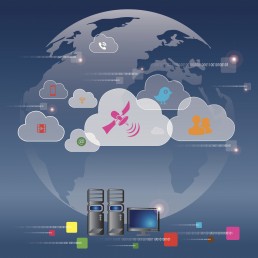Cloud Computing – Continuing to Mature in Ireland
The continuing adoption of cloud computing by Irish organizations is clear from research conducted by IDC in its IT Trends and Expenditure in Ireland 2017 survey. It was possible to compare the findings of the Irish research and a comprehensive IDC survey conducted across Europe a few months earlier. When we examined the IT investment priorities of organizations in the different countries we observe far more similarity than divergence.
‘Infrastructure optimization’ and ‘application consolidation/modernization’ are both in the top 3 ranked areas in Ireland and across Europe.
This provides us with a context for the growth of cloud computing in Ireland and elsewhere. More specifically, Irish survey respondents were asked to say which business applications they had moved to the cloud and which ones they planned to move in the next two years.
It is interesting to see how the evolution of the cloud market has been impacted depending on whether the migration decision has been driven by the IT function or by line of business personnel. Customer relationship management (CRM) and human capital management (HCM) are the most popular applications to have been moved to the cloud already by Irish organizations. Typically, such migrations have been driven by personnel outside of the IT department, in sales/marketing and HR. They are lower-risk applications which benefit from the availability of established cloud-products (e.g. Salesforce) to drive implementation. In the case of ‘supply chain / logistics’ and ‘financial applications’ the IT Trends survey shows that considerably fewer cloud migrations have taken place. These are central to the internal operations of the business and any plan to migrate these to the cloud would require comprehensive engagement by the IT department and line of business managers with significant risk taken by both. These applications also have the lowest levels of planned cloud migration in the next two years.
However, the areas that the survey respondents have primarily earmarked for cloud migration in the next two years are exclusively the domain of the IT function. These are ‘infrastructure (servers, storage)’ and ‘application development’. This should lead to a boost for the PaaS and IaaS markets in the near term.
The survey also provided some clues on the increasing maturity of the Irish market. There has been a sharp increase in the number of organizations who see ‘IT governance issues, including challenges related to defining standard services and SLAs’ as an inhibitor with regard to cloud implementation. Similarly, more organizations reported that cloud is ‘hard to integrate with in-house IT systems and management’ than did so in last year’s survey.
The prevalence of these issues suggests that Irish organizations involvement with cloud computing is maturing and moving toward greater dependency. This will assuredly continue. Indeed, Irish organizations, many of whom are planning digital transformation projects in the next two years, see cloud computing as a key facilitator. This is the correct approach in IDC’s view. Cloud models provide a strong foundation for digital transformation within organizations. In practice, organizations are likely to have a mix of public and private cloud services and these need to be integrated to provide a unified service to users. Further details on the status of digital transformation in Ireland as evidenced by the IT Trends survey can be found in another blog post
For more information check out IDC’s IT Trends and Expenditure in Ireland, 2017 report.
Netflix Dilemmas – Why You Need a Multicloud Strategy
Remember ten years ago? The word cloud had barely been coined and already pundits (must have been industry analysts) were predicting it would disappear. Cloud would become EVERYTHING, hence the concept would evaporate; i.e. be retired. Turned out somewhat differently. Today, everyone and their dog is using multiple cloud services in Europe. Think about a company (ANY company) you know, that has no productivity suites or HR capabilities delivered in SaaS mode, no virtualized resources on-premise, and no dedicated capacity at an external managed service provider.
Exactly — there aren’t any companies like that.
There have, however, been massive changes in the past ten years. People used to purchase hardware, now they consume it. Who’s still buying DVDs out there, when you’ve got Netflix, HBO Go, and Sky? More than half of the infra capacity in Europe will be going to service providers by 2020 according to us at IDC. All large IT buyers in Europe, from Deutsche Bahn to Dutch Post, have a cloud first strategy in place. They don’t want DVDs, they want the content. In many cases this will still be on-premise content, but consumed differently, in a flexible mode. In a growing number of scenarios, it will be content hosted and “streamed” by various service providers (xSPs).
This gives incredible freedom to users and developers, but it raises a bunch of scary questions for everyone else.
A Bunch of Scary Questions
High ranking IT buyers like Holger Fahner at Daimler are in the candy shop — but a lot of candies are poisoned! How do they avoid lock-in in large clouds? Can they patch together the multiple cloud back-ends they have? How about compliance and data governance?
These guys know it now: Cloud has anything but vanished — it has become #Multicloud.
IT departments are hardly the only ones pivoting. Hardware vendors are fighting for relevance. They’re also competing fiercely in the incredibly dispersed market for xSP infrastructure. There are thousands of tiny-to-massive customers with diverging requirements.
Even software and infrastructure cloud services providers are struggling to stand out from the crowd. How can they differentiate in the content overload? Can they make a jump and capture the on-premise wallets?
These Netflix dilemmas lead to a #Multicloud discussion in each and every ecosystem. After months of discussions with early adopters (think an online retailer like Expedia or an advanced incumbent like ING), we are now convinced that Multicloud environments will be the future in the European landscape.
Hybrid cloud consisted mostly of ad hoc bridges between different cloud environments. Multicloud is about IT decision makers getting back on the horse, measuring the costs and ensuring everything runs to perfection. It means moving from a multitude of unmanaged, potentially cost-inefficient cloud services to a programmatic setup of resources and a redesign of the internal processes.
But how can buyers get to that nirvana? How can vendors play a strategic role in those Multicloud journeys? Which technologies stand to win and lose in this brave new world?
Those dilemmas are at the core of our newly launched European Infrastructure for Multicloud research. We have recently published a first set of reports including
- Multicloud in Europe: Scenarios and Implications for IT Buyers
- Implications of the Code of Conduct for Cloud Infrastructure Service Providers in Europe
- IDC Survey Spotlight: European Attitudes Toward On- and Off-Premise Applications
We are investing the focus of our coverage on Service Provider infrastructure, on premise hardware consumption models and Multicloud readiness.
What do you guys think? Do you see the need of Multicloud out there in the marketplace? Make sure to join the conversation below!
If you have immediate questions, please contact Giorgio Nebuloni.
What is Sales Enablement? - Part 2: Analytics Enablement
In this post I laid out IDC’s original definition of sales enablement (i.e., “putting the right information into the hands of the right sales professional at the right time, in the right place, and in the right format to move a specific sales opportunity forward.”) and discussed some reasons for why we wanted to expand on it.
As part of that, I outlined three core sales enablement activities and discussed the first of these at length:
- Education enablement
- Analytics enablement
- Asset enablement
In this post, we’ll turn out attention to analytics enablement.
Analytics Enablement
Analytics enablement describes the software workbench that is jointly used by marketing and sales to closely monitor the buyer’s journey, with the objective of assessing their areas of interest, purchase intent, and urgency so that a smooth and timely introduction from marketing to sales can be affected when the time is right. When this introduction is made, analytics enablement also provides salespeople with as much information about the buyer as possible (e.g., footprints of interest left by the buyer during their online exploration), so that salespeople can quickly and efficiently pick up the interpersonal dialog while incorporating the knowledge already gained during the digital dialog.
It’s fairly obvious from the above description that I’m describing an idealized version of how things work in large organizations where the customer-creation process is divided into at least two major parts: the first covered by marketing, the latter covered by sales. I’ve also used a couple of terms that require definition: digital dialog and interpersonal dialog. The digital dialog is that part of the customer-creation process, managed by marketing, that engages the buyer through digital means, including advertising, Web sites, and email. The interpersonal dialog is that which ensues after sales engagement takes place, and is managed by the sales organization.
Thanks to the advent of marketing automation solutions, interaction during the early stages of buyer engagement can be very sophisticated, tracking buyer interest based on which emails and Web pages the buyer viewed and providing progressively more relevant information as a profile of buyer interest is developed. Thanks to this modern approach to lead nurturing, prospects can be scored so that only buyers most likely to be genuinely ready for sales engagement are passed along as leads.
In reality, this is rarely a perfect process, with the quality of leads being handed to sales a source of constant debate. That said, this digital dialog has had a dramatic impact on the customer-creation process, enabling a great deal of self-education to take place by buyers. Buyers like this ability and take advantage of it to better understand their options prior to engaging with sales.
This delayed engagement with sales means that today’s sellers have a smaller window of opportunity in which to influence the buyer’s journey as they pick up the interpersonal dialog that is theirs to manage. It also means today’s buyers are a whole lot smarter than they used to be and are looking for a different type of interaction. Gone are the days where buyers are happy with a long, drawn out sales process in which sellers can get to know the buyer as they impart hard-to-find product knowledge. Today, buyers get this information online and often understand their options better than many sales reps, especially when we include an understanding of the competition. This lost opportunity to gain buyer knowledge is why the Market and Buyer Education I discussed in my last post is so important. It’s also where analytics engagement can really help.
By providing information about specific buyers and selling opportunities, analytics enablement can send important signals to other parts of a selling organization’s enablement framework. For example, data indicating a particular prospect is a chief security officer at a healthcare company can trigger the delivery of training content tailored to that industry and persona-specific conversation guidance. Likewise, this same prospect might trigger a suggestion that the sales rep share a recent blog post or other thought leadership piece that is of particular relevance to that persona and industry.
This need to provide training that supports interaction with a particular buyer profile associated with a specific opportunity is a key driver of the trend toward microlearning. As described by Brian Leach in a blog post on the topic, microlearning is “the practice of delivering training in smaller, more focused chunks that learners can easily digest without committing large amounts of time to training.” Given the greater diversity of today’s buyers, this kind of “just in time” sales training, empowered by modern analytics enablement, can do a much better job of delivering sales enablement content exactly where’s it’s needed, just when it’s needed.
In addition to signaling when and where to deliver what sales enablement content, analytics enablement can also greatly enrich the lead handoff process. Just as a buyer’s interest profile developed by marketing automation systems can inform the lead nurturing process, it can also be used to educate salespeople about the leads they are being handed. Sadly, however, this information is rarely transmitted along with the lead. When it is, it usually takes the form of a raw data dump: pages visited, filed downloaded, etc. To understand the buyer’s areas of interest, the rep must go and view those pages and files and infer why the prospect chose to view them.
A much more valuable and efficient use of this data would be to pass along insights about what a prospect’s behavior during the digital dialog tells us about their interest and how and where the rep should pick up the conversation when they are engaged. This approach provides a much smoother transition between the digital and interpersonal dialogs and a better experience for the buyer. I can’t emphasize this last point enough—failure to provide reps with as much insight-level information about the buyer as possible during lead handoff forces the buyer to hit the rewind button and educate the sales rep about their areas of interest. This is a waste of everybody’s time and a big driver of buyer frustration.
It’s worth noting here that lead generation campaigns that make use of online tools to trade valuable information (e.g., technical maturity or business value assessments) for detailed prospect information (some of which is gathered as part of the assessment; some of which is requested in exchange for downloading the assessment report) can be another source of invaluable data. By embedding the collection of valuable prospect data within an experience the buyer finds worthwhile, marketers can not only learn a great deal about their target audience but also collect information of high value to downstream selling efforts. It’s well known that asking for prospect information lowers the likelihood that documents will be downloaded, but tools that provide real perceived value — benchmarking against peers is an excellent example — can often overcome this resistance and get prospective buyers to share their info.
As I’ve emphasized above, the more prospect information that can be gathered prior to sales engagement, the better enablement activities can be activated to produce highly relevant sales conversations
Sales enablement content flow
This discussion of how analytics enablement can be a vital part of your sales enablement strategy has surfaced an important concept: information gathered by marketing about the buyer should inform downstream sales activities. This notion of upstream/downstream information flow as part of the sales enablement process is important and points to the necessity of good sales and marketing collaboration. Given this imperative, I’ve been thrilled to see the massive uptick in marketing’s involvement in sales enablement over the past few years. That said, many organizations still have work to do.
A while back, I was in a meeting with the CMO of a large, enterprise software company where it was clear that he understood the value of sales enablement. What wasn’t clear was how much he understood the necessity of close collaboration with the sales organization to do it right. He did a wonderful job articulating how much work had been done by his organization to understand the buyer’s journey, so that they could map marketing content to that journey to ensure buyers were getting just the right information when they needed it. Referencing this work, I asked him if he was similarly mapping sales enablement content to the seller’s journey. He literally put his hand to his forehead. “You’re just throwing it over the wall, aren’t you?” I asked. “Yup,” he admitted. He is far from alone.
The information that marketing provides to sales as part of the sales enablement process will be of significantly higher value if it is delivered based on an understanding of the sales process. Just as the different stages of a buyer’s journey require different types of information, so too does the seller’s journey demand relevant and timely content delivery. In my next post on “What is Sales Enablement?” I’ll share a table Rich Vancil and I created to outline some sales enablement process roles for marketing and sales. I offer the tale above and that table in the hope that they can facilitate and foster an important dialog on how sales and marketing can partner to improve sales enablement content delivery.
For information about Sales Enablement, please contact Keith Gaffney - kgaffney@idc.com
There is No Silver Bullet When It Comes to GDPR in the Channel
The General Data Protection Regulations (GDPR) will be enforced from next May – and everyone in the technology industry is talking about it. So much so, the topic even took center stage at Microsoft Inspire – its massive annual global partner conference – earlier this month.
(This was especially interesting as the company and the event are US-based, so this dispels any myth that it only applies to European companies).
But unfortunately, the amount of people talking about an issue does not always directly correlate with the level of understanding there is about it. GDPR is a complex topic, and the regulations themselves come in the form of a lengthy legal document. However, if you thought GDPR was confusing by itself, it can be even more so when considering it in the context of the channel.
My role at IDC is to focus on Channels and Alliances, but we have a huge resource dedicated to all things security, specifically GDPR. Our GDPR experts provide detailed coverage of the nitty gritty details when it comes to the regulations, but in this blog, I wanted to bring it to life from a channel point of view. In its simplest and most basic form, the role of "data controller" is the data owner, for example, a bank, which owns data it collects from its customers: names and addresses, financial information, and so on. The bank determines the purpose and means by which the customer data is processed, making it a controller by definition. Any third-party processors of that data – a technology provider, for example - do so at the instruction of the controller, and become a "data processor". Simple, right?
But if that third-party data processor (the technology firm, in this example) uses that data for other purposes – monitoring or optimization, for example – they too become a controller, because they are determining what happens to it. The crucial distinction here is that, in this scenario, the third party does not become the data controller instead of the first data controller (the bank), but as well as. This is a concept it is essential to understand when it comes to channels, because there are significantly more layers of complexity added on top of an already dense topic. The nature of the channel means that there are multiple companies involved in the provision of a technology solution to a customer. Hence, there are many companies which could have access to, or control over, a customer's data.
A customer may work with one or two partners, which in turn could work with a distributor or two, and multiple vendors. The partner may even work with other channel firms in a partner-to-partner relationship, all on the same customer solution. So if the worst should happen and a breach occurs, there are many directions to which the finger of blame could point. This level of complexity has got the channel talking a lot over the last 12 months. Many companies are looking to position themselves as trusted advisors when it comes to GDPR, and many are re-packaging their solutions to speak directly to this challenge. And quite rightly so – customers need help.
But what it is so important to stress is that there is not one silver bullet when it comes to GDPR. No single company can make a customer bullet proof, and no single customer can completely outsource all GDPR-related responsibilities to a third-party. So what can you do? There are a number of steps which can be carried out by companies at all levels in the channel to ensure they are on top of the upcoming changes.
Advice for vendors
1) Gain genuine understanding into which parts of the channel have responsibility for what
2) Collect and retain evidence
3) Ensure your customers and partners know what you can and cannot provide
Advice for partners
1) Ensure you fully understand what your role is when it comes to customer data
2) Review customer contracts and retain documentation of having done so
2) Seek legal advice
Advice for customers
1) Accept that you're responsible for your customer data
2) Fully audit customer data
3) Consider data minimization
For further reading, please check out our recent market perspective: The Impact of GDPR for Channel-Centric Vendors
For more information about IDC's Channels & Alliances research an overview of the program is provided here.





